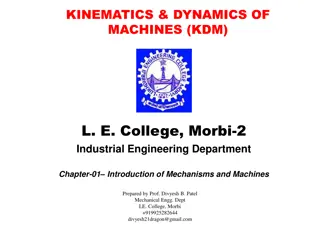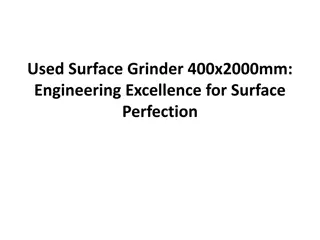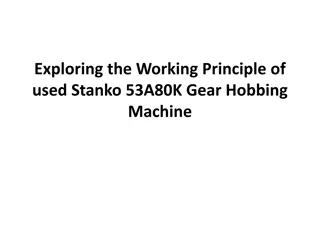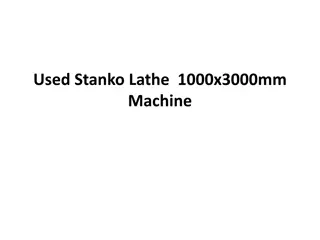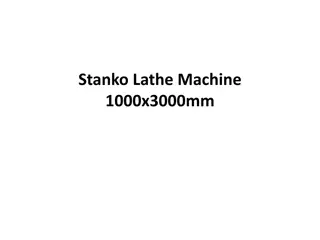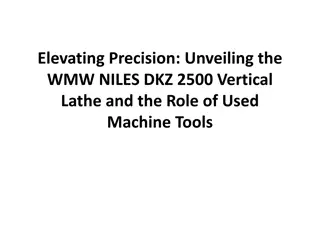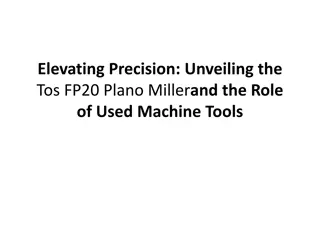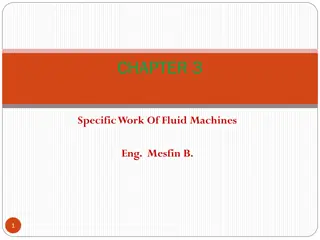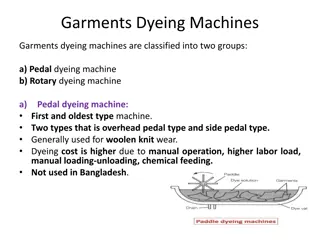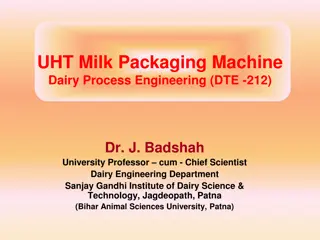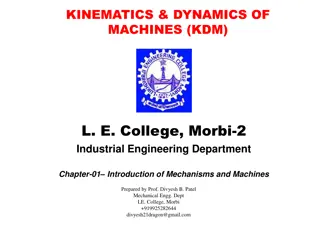
Unveiling the Electron-Ion Collider at BNL: A Cutting-Edge Research Facility
The Electron-Ion Collider (EIC) at Brookhaven National Laboratory (BNL) is a groundbreaking facility set to revolutionize particle physics research. With intricate designs and innovative features, the EIC aims to explore new frontiers in high-energy physics. From advanced detector technology to unique collider parameters, the EIC promises to push boundaries and unravel mysteries at the subatomic level.
Download Presentation

Please find below an Image/Link to download the presentation.
The content on the website is provided AS IS for your information and personal use only. It may not be sold, licensed, or shared on other websites without obtaining consent from the author. If you encounter any issues during the download, it is possible that the publisher has removed the file from their server.
You are allowed to download the files provided on this website for personal or commercial use, subject to the condition that they are used lawfully. All files are the property of their respective owners.
The content on the website is provided AS IS for your information and personal use only. It may not be sold, licensed, or shared on other websites without obtaining consent from the author.
E N D
Presentation Transcript
EIC at BNL and other EIC EIC at BNL and other EIC designs designs Mike Sullivan USPAS 2022 MS_10 1
EIC machine and backgrounds EIC machine and backgrounds The Electron-Ion Collider to be built at Brookhaven National Laboratory will recycle much of the RHIC hardware This collider will be one of the most complicated facilities ever made The proton energy will range up to 255 GeV and be polarized and have a current of 1A RHIC has already accomplished this goal at a lower beam current The electron storage ring will operate at 2 different energies 10 and 18 GeV and will have currents of 2.5 A and 0.26 A respectively It will also be polarized One of the most difficult parts of this project and a unique feature of this collider is that the detector needs to collect information from as much of the entire 4 solid angle as possible (you heard this from Yulia) 2
EIC layout EIC layout The yellow and blue rings are the original RHIC proton rings They will take out the cold proton blue ring and replace it with a warm 18 GeV electron ring They also need a booster ring (red circle) for the electrons so that they can inject into the electron storage ring with an on- energy bunch 3
Parameters of the EIC Parameters of the EIC at max lumi at max lumi EIC parameters for max lumi running Electron beam has 2.5 A Total electron RF power to the beam is 9.18 MW 10 MW is a design constraint 4
EIC and backgrounds (2) EIC and backgrounds (2) The need to collect particles from interactions all the way down to the beam envelope and even inside the beam envelope makes this a unique challenge for both the detector and the accelerator Particles that have interacted and are inside the beam envelope can still be detected if they have lost enough energy to come out of the beam envelope either inside or just after passing through a bend magnet They will be over bent and then they can be intercepted by a detector located very close to the beam envelope roman pot technology One of the main reasons for wanting to do this is to study the skin or surface of the proton (mentioned by Yulia yesterday) This design will be moving into new territory in attempting to have detector components this close to a high current electron beam Detectors close to the beam have been installed in the LHC and also in previous proton rings but not in a high current electron ring 5
EIC and backgrounds (3) EIC and backgrounds (3) There are a several beam interactions that occur with a high rate at very small scattering angles Beam-gas interactions Coherent effects from the collision The tune shift from the collision Synchrotron radiation most of the beam particles contribute to very low angle SR These beam related events are not at all interesting from a detector standpoint, yet they may overwhelm the signals of interest, or they may swamp the detector rendering it useless There are several studies that are ongoing right now to get an idea of what kind of backgrounds might cover up the low-angle scattering data of interest and how one might reduce the calculated background levels 6
Other collider issues related to the collision Other collider issues related to the collision The detectors of modern and future colliders are asking for polarized beams This is very hard to do in electron/positron storage rings The storage ring will tend to depolarize the beam rather quickly if nothing is done to slow down or prevent the depolarization Protons and deuterons have been polarized (e.g. in RHIC) Thomas Jefferson National Laboratory at Newport News, VA had a proposal to use a figure 8 ring design for the EIC This design preserves the polarization of the beam because the depolarization of one arc of the figure 8 is canceled by the other arc since the beam effectively moves backward through the 2nd arc reversing the depolarization effects 7
Polarization Polarization The SLAC Linear Collider (SLC) which was first to collide at the Z resonance, but then the LEP accelerator came online and produced a much higher rate of Zs, so the SLC turned to developing polarized beams and subsequently have produced polarization measurements of Z events so far unsurpassed by any other e+e- colliders Linear colliders have a distinct advantage over storage rings for producing polarized beams The EIC at BNL plans to inject newly polarized bunches into the storage ring in order to maintain a highly polarized electron beam There are some studies going on to try to polarize the stored beams in the SuperKEKB 8
The Polarimeter The Polarimeter A polarized beam needs a polarimeter to measure the amount of polarization The polarimeter uses a laser beam to shine light (eV) photons onto the stored beam bunch A particle in the bunch collides with one of the laser photons and the photon bounces off the beam particle (Compton scatters) with a good fraction of the beam particle energy (~GeV) that can be detected by having a thin section of beam pipe at the spot where the high energy photons can go through without much scattering or interacting In addition, the beam particle (electron or positron) that interacted have lost (~GeV) energy and so they will be over bent in the next dipole magnet These overbent particles can then be detected by a device close to the beam envelope 9
Backgrounds in the Polarimeter Backgrounds in the Polarimeter From the previous slide we see that the polarimeter has the same issues as the main detector in that it needs to place detectors very close to the beam envelope down where there can be a lot of background from other beam interactions In addition, the Compton photons generated by the interaction need to exit the beam pipe through a window thin enough to let the high energy gamma get through but thick enough to prevent the SR x-rays generated by the local dipoles and quadrupoles from getting through and swamping the detector 10
Backgrounds in the polarimeter (1) Backgrounds in the polarimeter (1) I studied backgrounds in the polarimeter design for the JLAB EIC proposal ( I have a writeup on the photon window estimates) I found that the SR fan of radiation that strikes the opposite side of the beam pipe can scatter enough x-ray photons to the electron tagger to cause problems especially if the detector is in the same vacuum as the beam My estimates said that we need to build an antechamber on the opposite side of the detector so that most (if not all) of the fan radiation ends up striking a sloped dump that has no view to the electron detector This antechamber and the electron detector will make a very large impedance issue in this area and that will also need to be carefully studied 11
SR in other places around the ring SR in other places around the ring Moving farther away from the IR momentarily, there are several other places around the ring that need studying with respect to SR in a high current storage ring This is aside from the obvious fact that one must absorb the total SR power The RF cavities cannot tolerate much in the way of either direct SR or scattered SR from upstream magnets this is especially true of superconducting RF Any superconducting elements that have a cryogenic beam pipe must be protected from synchrotron radiation the photons will tend to desorb any gas molecules on the surface as well as deposit energy into the beam pipe Spin rotators Solenoid compensators usually SC to save Z space Crab cavities Possible final focus quads although all current designs are striving to keep the beam pipe warm here These topics can be issues for standard light sources that employ high beam currents 12
Future electron ion colliders Future electron ion colliders SR absorber We will take a quick look at possible future electron ion colliders First, we have the LHeC This design proposes to collide a 60 GeV electron beam with a 7 TeV proton beam IR layout and design Reference: LHeC CDR, J. Phys. G: Nucl. Part. Phys. 39 (2012) 075001 13
FCC FCC- -eh This collider is still very much in the design stage The present thinking is to have a 60 GeV electron beam as was proposed in the LHeC design The proton beam energy is now 20 - 50 TeV The interaction region would look quite similar to the LHeC design In this case, the electron beam issues will be very similar for both designs Both of these colliders are interested in Deep Inelastic Scattering (DIS) This is a way to look inside the proton and in this respect the interest is in looking for structure inside the quarks eh 14
Summary Summary The EIC designs are pushing the collider frontier in another direction that of wanting to have a complete (or as near complete as possible) 4 detector They are putting detectors in front of the FF quads They are using bending magnets to get scattered beam particles out of the beam envelope They have detectors at zero degrees They need very large aperture final focus magnets in the proton forward side in order to prevent small scattered protons from hitting the magnets These are all new constraints on the machine making this one of the most challenging colliders ever to be designed 15




